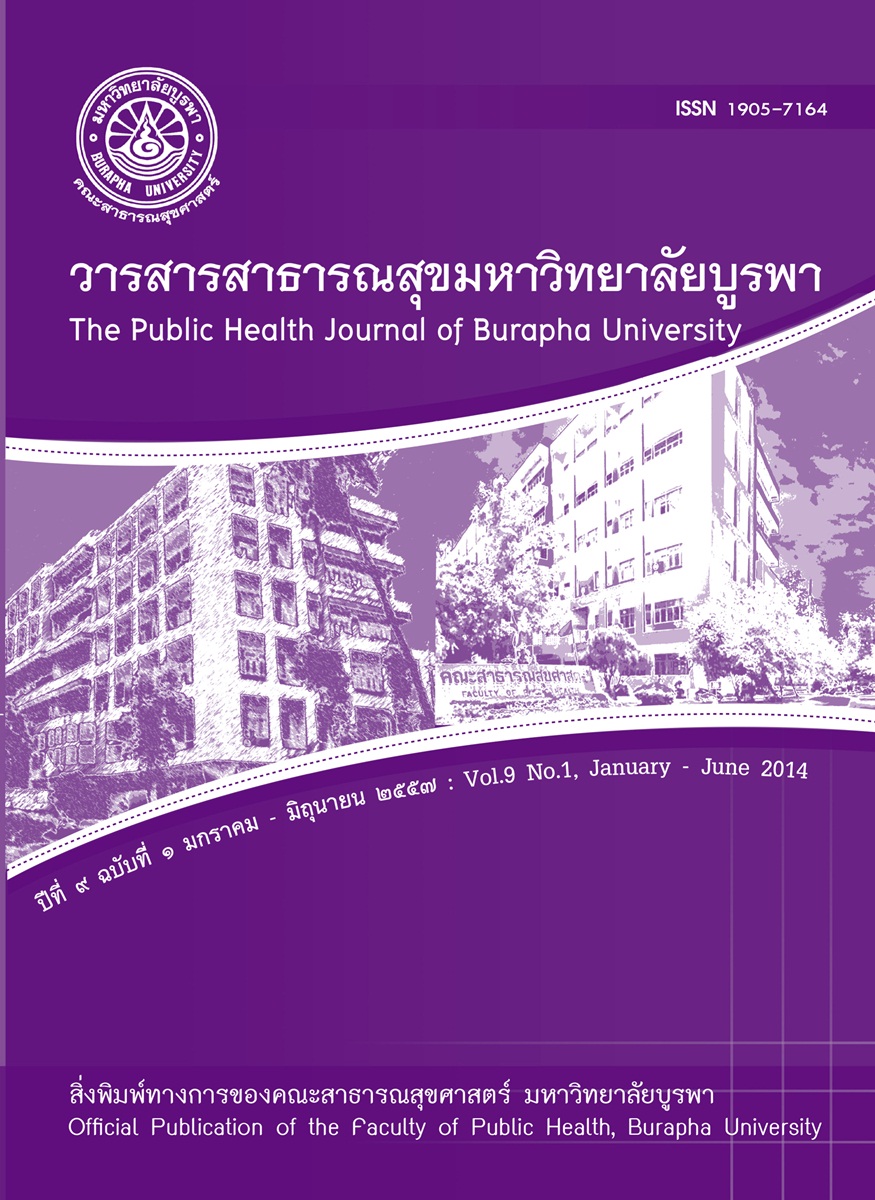ผลของการใช้แบบแผนความเชื่อด้านสุขภาพและแรงสนับสนุนทางสังคมต่อพฤติกรรมการรับประทานอาหารและระดับความเข้มข้นของโลหิตในผู้สูงอายุที่มีภาวะโลหิตจางจากการขาดธาตุเหล็ก
Main Article Content
บทคัดย่อ
การวิจัยนี้เป็นการวิจัยกึ่งทดลองแบบศึกษาสองกลุ่มวัดผลก่อนและหลังการทดลอง เพื่อศึกษาผลของการใช้แบบแผนความเชื่อด้านสุขภาพและแรงสนับสนุนทางสังคมต่อพฤติกรรมการรับประทานอาหารและระดับความเข้มข้นของโลหิตในผู้สูงอายุที่มีภาวะโลหิตจางจากการขาดธาตุเหล็ก กลุ่มตัวอย่าง คือ ผู้สูงอายุที่มีภาวะโลหิตจางจากการขาดธาตุเหล็กที่อาศัยอยู่ในอำเภอสามโคก จังหวัดปทุมธานีที่มีอายุ 60 ปี ขึ้นไป (โดยมีระดับความเข้มข้นของโลหิตระหว่าง 31-38 mg% ในเพศชายและ 31-35 mg% ในเพศหญิง) จำนวน 50 คน แบ่งเป็นกลุ่มทดลอง 25 คน กลุ่มควบคุม 25 คน ใช้วิธีการสุ่มตัวอย่างแบบหลายขั้นตอนร่วมกับจับคู่ตัวแปร เพศ อายุ ระดับการศึกษา และรายได้ กลุ่มทดลองมีการใช้แนวคิดแบบแผนความเชื่อด้านสุขภาพร่วมกับการให้แรงสนับสนุนทางสังคมโดยสมาชิกครอบครัวและพยาบาลเวชปฏิบัติชุมชนเป็นเวลา 12 สัปดาห์ กลุ่มควบคุมได้รับการดูแลตามปกติ เครื่องมือที่ใช้ในการเก็บรวบรวมข้อมูลเป็นแบบสัมภาษณ์ข้อมูลส่วนบุคคล พฤติกรรมการรับประทานอาหาร และแบบบันทึกระดับความเข้มข้นของโลหิตที่ผู้วิจัยสร้างขึ้นโดยแบบสัมภาษณ์พฤติกรรมการรับประทานอาหารมีค่าความเชื่อมั่นระดับปานกลาง (α = .70) วิเคราะห์ข้อมูลใช้สถิติ การแจกแจงความถี่ ร้อยละ ค่าเฉลี่ย ค่าเบี่ยงเบนมาตรฐาน ไคสแควร์ และ การวิเคราะห์ความแปรปรวนร่วม เพื่อเปรียบเทียบพฤติกรรมการรับประทานอาหารและระดับความเข้มข้นของโลหิตก่อนและหลังการทดลอง ผลการวิจัยพบว่า กลุ่มทดลองและกลุ่มควบคุมมีค่าเฉลี่ยพฤติกรรมการรับประทานอาหารหลังการทดลองแตกต่างกันอย่างมีนัยสำคัญทางสถิติที่ระดับ .05 กลุ่มทดลองมีพฤติกรรมการรับประทานอาหารที่ถูกต้องมากกว่ากลุ่มควบคุม ค่าเฉลี่ยระดับความเข้มข้นของโลหิตหลังการทดลองแตกต่างกันอย่างมีนัยสำคัญทางสถิติที่ระดับ .05 ซึ่งกลุ่มทดลองมีระดับความเข้มข้นของโลหิตมากกว่ากลุ่มควบคุม ข้อเสนอจากการวิจัยครั้งนี้ คือ การนำแนวคิดแบบแผนความเชื่อด้านสุขภาพร่วมกับการให้แรงสนับสนุนทางสังคมโดยสมาชิกครอบครัวและพยาบาลเวชปฏิบัติชุมชนไปประยุกต์ใช้กับผู้สูงอายุที่มีภาวะโลหิตจางจากการขาดธาตุเหล็กในชุมชนอื่น ๆ ต่อไป
This study was a quasi-experimental study with 2 groups, pretest-posttest design. The purpose of the study was to determine the effects of the health belief model and social support theory on eating behavior and hematocrit of older adults having iron deficiency anemia. The sample was older adults having iron deficiency anemia who lived in Sam Khok district, Pathumthani province. There were 50 older adults divided into experimental and control group, 25 persons for each group. Multistage random sampling techniques and matched by sex, age, education and income were used. The experimental group received the intervention based on the health belief model and social support theory. Duration of the intervention was 12 weeks. The control group received usual care. Instruments used for collecting data were general demographic characteristics questionnaires, eating behaviors structured interview guidelines, and hematocrit record form created by the researcher. The reliability of eating behavior was at median level (α = .70). Statistical analysis used in the study were frequency, percentage, mean, standard deviation; and Chi-square and analysis of covariance were used compare the eating behavior and hematocrit change between pre-post test.
The results showed that eating behavior and hematocrit level of the experimental group had significantly different from the control group (p <05). Both of eating behavior and hematocrit level among older adults in the experimental group was higher than those in the control group (p <05). These findings suggested that this concept the health belief model and social support by family members and community nursing practice applied to the elderly with iron deficiency anemia in other communities.

